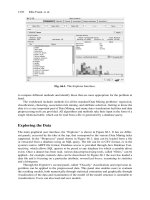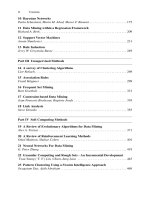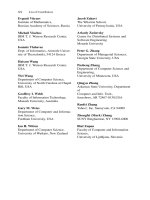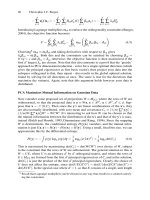Data Mining and Knowledge Discovery Handbook, 2 Edition part 25 pptx
Bạn đang xem bản rút gọn của tài liệu. Xem và tải ngay bản đầy đủ của tài liệu tại đây (149.63 KB, 10 trang )
220 Richard A. Berk
Consider now an application of the generalized additive model. For data de-
scribed earlier, Figure 11.3 shows the relationship between number of homicides
and the number executions a year earlier, with state and year held constant. Indicator
variables are included for each state to adjust for average differences over time in the
number of homicides in each state. For example, states differ widely in population
size, which is clearly factor in the raw number of homicides. Indicator variables for
each state control for such differences. Indicator variables for year are included to
adjust for average differences across states in the number of homicides each year.
This controls for year to year trends for the country as a whole in the number of
homicides.
There is now no apparent relationship between executions and homicides a year
later except for the handful of states that in a very few years had a large number of
executions. Again, any story is to be found in a few extreme outliers that are clearly
atypical. The statistical point is that one can accommodate with GAM both smoother
functions and conventional regression functions.
Figure 11.4 shows the relationship between number of homicides and 1) the num-
ber executions a year earlier and 2) the population of each state for each year. The
two predictors were included in an additive fashion with their functions determined
by smoothers.
The role of execution is about the same as in Figure 11.3, although at first glance
the new vertical scale makes it looks a bit different. In addition, one can see that
homicides increase monotonically with population size, as one would expect, but the
rate of increase declines. The very largest states are not all that different from middle
sized states.
11.7 Recursive Partitioning
Recall again equation 11.3 reproduced below for convenience as equation 11.14:
f (x)=
p
∑
j=1
M
j
∑
m=1
β
jm
h
jm
(x), (11.14)
An important special case sequentially includes basis functions that contribute to
substantially to the fit. Commonly, this is done in much the same spirit as forward
selection methods in stepwise regression. But, there are now two components to the
fitting process. A function for each predictor is constructed. Then, only some of these
functions are determined to be worthy and included in the final model. Classification
and Regression Trees (Breiman et al., 1984), commonly known as CART, is probably
the earliest and most well known example of this approach.
11.7.1 Classification and Regression Trees and Extensions
CART can be applied to both categorical and quantitative response variables. We will
consider first categorical response variables because they provide a better vehicle for
explaining how CART functions.
11 Regression Framework 221
Fig. 11.4. GAM Homicide Results with Executions and Population as Predictors
CART uses a set of predictors to partition the data so that within each partition
the values of the response variable are as homogeneous as possible. The data are
partitioned one partition at a time. Once a partition is defined, it is unaffected by later
partitions. The partitioning is accomplished with a series of straight-line boundaries,
which define a break point for each selected predictor. Thus, the transformation for
each predictor is an indicator variable.
Figure 11.5 illustrates a CART partitioning. There is a binary outcome coded “A”
or “B” and in this simple illustration, just two predictors, x and z, are selected. The
222 Richard A. Berk
single vertical line defines the first partition. The double horizontal line defines the
second partition. The triple horizontal line defines the third partition.
The data are first segmented left from right and then for the two resulting par-
titions, the data are further segmented separately into an upper and lower part. The
upper left partition and the lower right partition are perfectly homogeneous. There
remains considerable heterogeneity in the other two partitions and in principle, their
partitioning could continue. Nevertheless, cases that are high on z and low on x are
always “B.” Cases that are low on z and high on x are always “A.” In a real analy-
sis, the terms “high” and “low” would be precisely defined by where the boundaries
cross the x and z axes.
Fig. 11.5. Recursive Partitioning Logic in CART
The process by which each partition is constructed depends on two steps. First,
each potential predictor individually is transformed into the indicator variable best
able to split the data into two homogenous groups. All possible break points for
each potential predictor are evaluated. Second, the predictor with the most effective
indicator variable is selected for construction of the partition. For each partition, the
process is repeated with all predictors, even ones used to construct earlier partitions.
As a result, a given predictor can be used to construct more than one partition; some
predictors will have more than one transformation selected.
Usually, CART output is displayed as an inverted tree. Figure 11.6 is a simple
illustration. The full data set is contained in the root node. The final partitions are
11 Regression Framework 223
subsets of the data placed in the terminal nodes. The internal nodes contain subsets
of data for intermediate steps.
Fig. 11.6. CART Tree Structure
To achieve as much homogeneity as possible within data partitions, heterogeneity
within data partitions is minimized. Two definitions of heterogeneity that are espe-
cially common. Consider a response that is a binary variable coded 1 or 0. Let the
224 Richard A. Berk
“impurity” i of node
τ
be a non-negative function of the probability that y = 1.If
τ
is
a node composed of cases that are all 1’s or all 0’s, its impurity is 0. If half the cases
are 1’s and half the cases are 0’s,
τ
is the most impure it can be. Then, let
i(
τ
)=
φ
[p(y = 1|
τ
)], (11.15)
where
φ
≥ 0,
φ
(p)=
φ
(1 −p), and
φ
(0)=
φ
(1) <
φ
(p). Impurity is non-negative,
symmetrical, and is at a minimum when all of the cases in
τ
are of one kind or
another. The two most common options for the function
φ
are the entropy function
shown in equation 11.16 and the Gini Index shown in equation 11.17:
12
φ
(p)=−plog(p) −(1 −p) log(1 −p); (11.16)
φ
(p)=p (1 −p). (11.17)
Both equations are concave with minimums at p = 0 and p = 1 and a maximum
at p = .5. CART results from the two are often quite similar, but the Gini index
seems to perform a bit better, especially when there are more than two categories in
the response variable.
While it may not be immediately apparent, entropy and the Gini index are in
much same spirit as the least squares criterion commonly use in regression, and the
goal remains to estimate a set of conditional means. Because in classification prob-
lems the response can be coded asa1ora0,themean is a proportion.
Figure 11.7 shows a classification tree for an analysis of misconduct engaged in
my inmates in prisons in California. The data are taken from a recent study of the
California inmate classification system (Berk et al., 2003). The response variable is
coded 1 for engaging in misconduct and 0 otherwise. Of the eight potential predic-
tors, three were selected by CART: whether an inmate had a history of gang activity,
the length of his prison term, and his age when he arrived at the prison reception
center.
A node in the tree is classified as 1 if a majority of inmates in that node engaged
in misconduct and 0 if a majority did not. The pair of numbers below each node clas-
sification show how the inmates are distributed with respect to misconduct. The right
hand number is the count of inmates in the majority category. The left hand number
is the count of inmates in the minority category. For example, in the terminal node
at the far right side, there are 332 inmates. Because 183 of the 332 (55%) engaged
in misconduct, the node is classified as a 1. The terminal nodes in Figure 11.7 are
arranged so that the proportion of inmates engaging in misconduct increases from
left to right.
In this application, one of the goals was to classify inmates by predictors of their
proclivity to cause problems in prison. For inmates in the far right terminal node, if
one claimed that all had engaged in misconduct, that claim would be incorrect 44%
of the time. This is much better than one would do ignoring the predictors. In that
12
Both can be generalized for nominal response variables with more than two categories
(Hastie et al., 2001).
11 Regression Framework 225
Fig. 11.7. Classification Tree for Inmate Misconduct
case, if one claimed that all inmates engaged in misconduct, that claim would be
wrong 79% of the time.
The first predictor selected was gang activity. The “a” indicates that the inmates
with a history of gang activity were placed in the right node, and inmates with a
history of no gang activity were placed in the left node. The second predictor selected
was only able meaningfully to improve the fit for inmates with a history of gang
activity. Inmates with a sentence length (“Term”) of less than 2.5 years were assigned
to the left node, while inmates with a sentence length of 2.5 years or more were
assigned to the right node. The final variable selected was only able meaningfully
to improve the fit for the subset of inmates with a history of gang activity who were
serving longer prison terms. That variable was the age of the inmate when he arrived
at the prison reception center. Inmates with ages greater than 25 (age categories b,
c, and d) were assigned to the left node, while inmates with ages less than 25 were
assigned to the right node. In the end, this sorting makes good subject-matter sense.
Prison officials often expect more trouble from younger inmates with a history of
gang activity serving long terms.
When CART is applied with a quantitative response variable, the procedure is
known as “Regression Trees.” At each step, heterogeneity is now measured by the
within-node sum of squares of the response:
i(
τ
)=
∑
(y
i
− ¯y(
τ
))
2
, (11.18)
where for node
τ
the summation is over all cases in that node, and ¯y(
τ
) is the mean
of those cases. The heterogeneity for each potential split is the sum of the two sums
226 Richard A. Berk
of squares for the two nodes that would result. The split is chosen that reduces most
this within-nodes sum of squares; the sum of squares of the parent node is compared
to the combined sums of squares from each potential split into two offspring nodes.
Generalization to Poisson regression (for count data) follows with the deviance used
in place of the sum of squares.
11.7.2 Overfitting and Ensemble Methods
CART, like most Data Mining procedures, is vulnerable to overfitting. Because the
fitting process is so flexible, the mean function tends to “over-respond” to idiosyn-
cratic features of the data. If the data on hand are a random sample for a particular
population, the mean function constructed from the sample can look very different
from the mean function in the population (were it known). One implication is that a
different random sample from the same population can lead to very different charac-
terizations of how the response is related to the predictors. Conventional responses to
overfitting (e.g., model selection based on the AIC) are a step in the right direction.
However, they are often not nearly strong enough and usually provide few clues how
a more appropriate model should be constructed.
It has been known for nearly a decade that one way to more effectively counter-
act overfitting is to construct average results over a number of random samples of
the data (LeBlanc and Tibshirani, 1996, Mojirsheibani, 1999,Friedman et al., 2000).
Cross-validaton can work on this principle. When the samples are bootstrap samples
from a given data set, the procedures are sometimes called ensemble methods, with
“bagging” as an early and important special case (Breiman, 1996).
13
Bagging can be
applied to a wide variety of fitting procedures such as conventional regression, logis-
tic regression and discriminant function analysis. Here the focus will be on bagging
regression and classification trees.
The basic idea is that the various manifestations of overfitting cancel out in the
aggregate over a large number of independent random samples from the same popu-
lation. Bootstrap samples from the data on hand provide a surrogate for independent
random samples from a well-defined population. However, the bootstrap sampling
with replacement implies that bootstrap samples will share some observations with
one another and that, therefore, the sets of fitted values across samples will not be
independent. A bit of dependency is built it.
For recursive partitioning, the amount of dependence can be decreased substan-
tially if in addition to random bootstrap samples, potential predictors are randomly
sampled (with replacement) at each step. That is, one begins with a bootstrap sam-
ple of the data having the same number of observations as in the original data set.
Then, when each decision is made about subdividing the data, only a random sample
of predictors is considered. The random sample of predictors at each split may be
relatively small (e.g., 5).
“Random forests” is one powerful approach exploiting these ideas. It builds on
CART, and will generally fit the data better than standard regression models or CART
13
“Bagging” stands for bootstrap aggregation.
11 Regression Framework 227
itself (Breiman, 2001a). A large number of classification or regression trees is built
(e.g., 500). Each tree is based on a bootstrap sample of the data on hand, and at each
potential split, a random sample of predictors is considered. Then, average results
are computed over the full set of trees. In the binary classification case, for example,
a “vote” is taken over all of the trees to determine if a given case is assigned to one
class or the other. So, if there are 500 trees and in 251 or more of these trees that case
is classified as a “1,” that case is treated as a “1.”
One problem with random forests is that there is no longer a tree to interpret.
14
Partly in response to this defect, there are currently several methods under develop-
ment that attempt to represent the importance of each predictor for the average fit.
Many build on the following approach. The random forests procedure is applied to
the data. For each tree, observations not included in the bootstrap sample are used
as a “test” data set.
15
Some measure of the quality of the fit is computed with these
data. Then, the values of a given explanatory variable in the test data are randomly
shuffled, and a second measure of fit quality computed. Each of the measures is then
averaged across the set of constructed trees. Any substantial decrease in the quality
of the fit when the average of the first is compared to the average of the second must
result from eliminating the impact of the shuffled variable.
16
The same process is
repeated for each explanatory variable in turn.
There is no resolution to date of exactly what feature of the fit should be used to
judge the importance of a predictor. Two that are commonly employed are the mean
decline over trees in the overall measure of fit (e.g. the Gini Indix) and for classifi-
cation problems, the mean decline over trees in how accurately cases are predicted.
For example, suppose that for the full set explanatory variables an average of 75%
of the cases are correctly predicted. If after the values of a given explanatory vari-
able are randomly shuffled that figure drops to 65%, there is a reduction in predictive
accuracy of 10%. Sometimes a standardized decline in predictive accuracy is used,
which may be loosely interpreted as a z-score.
Figure 11.8 shows for the prison misconduct data how one can consider predictor
importance using random forests. The number of explanatory variables included in
the figure is truncated at four for ease of exposition. Term length is the most impor-
tant explanatory variable by both the predictive accuracy and Gini measures. After
that, the rankings from the two measures vary. Disagreements such as these are com-
mon because the Gini Index reflects the overall goodness of fit, while the predictive
accuracy depends on how well the model actually predicts. The two are related, but
they measure different things. Breiman argues that the decrease in predictive accu-
racy is the more direct, stable and meaningful indicator of variable importance (per-
sonal communication). If the point is to accurately predict cases, why not measure
14
More generally, ensemble methods can lead to difficult interpretative problems if the links
of inputs to outputs are important to describe.
15
These are sometimes called “out-of-bag” observations. “Predicting” the values of the re-
sponse for observations used to build the set of trees will lead to overly optimistic assess-
ments of how well the procedure performs. Consequently, out-of-bag (OOB) observations
are routinely used in random forests to determine how well random forests predicts.
16
Small decreases could result from random sampling error.
228 Richard A. Berk
Fig. 11.8. Predictor Importance using Random Forests
importance by that criterion? In that case, the ranking of variables by importance is
term length, gang activity, age at reception, and age when first arrested.
When the response variable is quantitative, importance is represented by the av-
erage increase in the within node sums of squares for the terminal nodes. The in-
crease in this error sum of squares is related to how much the “explained variance”
decreases when the values of a given predictor are randomly shuffled. There is no
useful analogy in regression trees to correct or incorrect prediction.
11 Regression Framework 229
11.8 Conclusions
A large number of Data Mining procedures can be considered within a regression
framework. A representative sample of the most popular and powerful has been dis-
cussed in this chapter.
17
With more space, others could have been included: boost-
ing (Freund and Schapire, 1995) and support vector machines (Vapnik, 1995) are
two obvious candidates. Moreover, the development of new data mining methods
is progressing very quickly, stimulated in part by relatively inexpensive computing
power and in part by the Data Mining needs in a variety of disciplines. A revision
of this chapter five years from now might look very different. Nevertheless, a key
distinction between the more effective and the less effective Data Mining procedures
is how overfitting is handled. Finding new and improved ways to fit data is often
quite easy. Finding ways to avoid being seduced by the results is not (Svetnik et al.,
2003, Reunanen, 2003).
Acknowledgments
The final draft of this chapter was funded in part by a grant from the National Science
Foundation: (SES -0437169) ”Ensemble methods for Data Analysis in the Behav-
ioral, Social and Economic Sciences.” This chapter was completed while visiting at
the Department of Earth, Atmosphere, and Oceans, at the Ecole Normale Sup
´
erieur
in Paris. Support from both is gratefully acknowledged.
References
Berk, R.A. (2003) Regression Analysis: A Constructive Critique. Newbury Park, CA.: Sage
Publications.
Berk, R.A., Ladd, H., Graziano, H., and J. Baek (2003) “A Randomized Experiment Testing
Inmate Classification Systems,” Journal of Criminology and Public Policy, 2, No. 2:
215-242.
Breiman, L., Friedman, J.H., Olshen, R.A., and C.J. Stone, (1984) Classification and Regres-
sion Trees. Monterey, Ca: Wadsworth Press.
Breiman, L. (1996) “Bagging Predictors.” Machine Learning 26:123-140.
Breiman, L. (2000) “Some Infinity Theory for Predictor Ensembles.” Technical Report 522,
Department of Statistics, University of California, Berkeley, California.
Breiman, L. (2001a) “Random Forests.” Machine Learning 45: 5-32.
Breiman, L. (2001b) “Statistical Modeling: Two Cultures,” (with discussion) Statistical Sci-
ence 16: 199-231.
Cleveland, W. (1979) “Robust Locally Weighted Regression and Smoothing Scatterplots.”
Journal of the American Statistical Association 78: 829-836.
Cook, D.R. and Sanford Weisberg (1999) Applied Regression Including Computing and
Graphics. New York: John Wiley and Sons.
17
All of the procedures described in this chapter can be easily computed with procedures
found in the programming language R.









